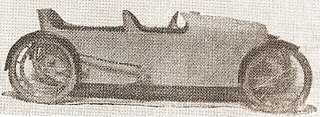
A cyclecar was a type of small, lightweight and inexpensive car manufactured in Europe and the United States between 1910 and the early 1920s. The purpose of cyclecars was to fill a gap in the market between the motorcycle and the car. A key characteristic was that it could only accommodate two passengers sitting tandem style or passenger behind the driver.

Anzani was an engine manufacturer founded by the Italian Alessandro Anzani (1877–1956), which produced proprietary engines for aircraft, cars, boats, and motorcycles in factories in Britain, France and Italy.

The Argo was a short-lived United States automobile manufactured by the Argo Motor Co in Jackson, Michigan, between 1914 and 1918. Previously, the factory had been used by the Standard Electric Car Co to build an electric car.

The Oakland Motor Car Company of Pontiac, Michigan, was an American automobile manufacturer and division of General Motors. Purchased by General Motors in 1909, the company continued to produce modestly priced automobiles until 1931 when the brand was dropped in favor of the division's Pontiac make.

JA Prestwich Industries, was a British engineering equipment manufacturing company named after founder John Alfred Prestwich, which was formed in 1951 by the amalgamation of J.A.Prestwich and Company Limited and Pencils Ltd.

The Marion was an automobile produced by the Marion Motor Car Company in Indianapolis, Indiana from 1904 to 1915.

Coventry Premier Limited owned a British car and cyclecar manufacturing business based in Coventry from 1912 to 1923. It changed its name from Premier Cycles to Coventry Premier Ltd in November 1914.

The LuLu cyclecar was produced by the Kearns Motor Truck Company n Beavertown, Snyder County, Pennsylvania from 1914 to 1915.
The term light car is used in Great Britain since the early part of the 20th century for an automobile less than 1.5 litres engine capacity. In modern car classification this term would be roughly equivalent to a subcompact car. There are numerous light car clubs in Britain and Australia.

The Speedwell Motor Car Company was a Brass Era American automobile manufacturing company established by Pierce Davies Schenck that produced cars from 1907 to 1914. The Great Dayton Flood of 1913 greatly damaged the Speedwell factory and inventory, and the company entered receivership in 1915 after having built an estimated 4,000 cars and trucks.
The Detroit Cyclecar was a cyclecar manufactured in Detroit, Michigan by the Detroit Cyclecar Company from 1913 to 1914 and Saginaw, Michigan in 1914.

The Mercury was a cyclecar built in Detroit, Michigan, by the Mercury Cyclecar Company at 807 South Scotten Street in 1913-1914.

Scripps-Booth was a United States automobile marque based in Detroit, Michigan. Established by James Scripps Booth in 1913, Scripps-Booth Company produced motor vehicles and was later acquired by General Motors, becoming a division of it, until the brand was discontinued in 1923.

The Partin Manufacturing Company was a brass era American automobile manufacturer, headquartered at 29 South LaSalle Street, Chicago, Illinois from 1913 to 1917. The Partin-Palmer automobile and Pioneer cyclecar were produced.
National Aircraft Factory No. 2 was a World War I UK government owned aircraft factory located at Heaton Chapel, Stockport. It produced over 450 warplanes during 1918/19. The Heaton Chapel factory was then sold to Crossley Motors, who used it for building motor vehicles. In 1934, it was sold to the Fairey Aviation Company, with aircraft production there continuing until the late 1950s.

The Regal was an American automobile produced by the Regal Motor Car Company of Detroit, Michigan, from 1907 to 1918.

The W. H. Kiblinger Company and the W. H. McIntyre Company produced Brass Era automobiles in Auburn, Indiana from 1907 to 1915.

The Signet cyclecar was the name used by Fenton Engineering Company of Fenton, Michigan from 1913 to 1914. In 1914 the name was changed to Fenton and was manufactured by the Fenton Cyclecar Company. In May 1914, The Fenton became the Koppin and was produced by the Koppin Motor Company until September 1914.
The States was a cyclecar manufactured by the States Cyclecar Company of Detroit, Michigan in 1915.















